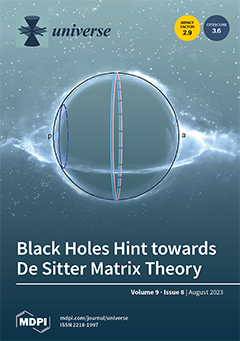The matter fluctuation parameter
is, by model construction, degenerate with the growth index
. Here, we study the effect on the cosmological parameter constraints by treating each independently from one another, considering
as a free and non-derived parameter
[...] Read more.
The matter fluctuation parameter
is, by model construction, degenerate with the growth index
. Here, we study the effect on the cosmological parameter constraints by treating each independently from one another, considering
as a free and non-derived parameter along with a free
. We then try to constrain all parameters using three probes that span from deep to local redshifts, namely the CMB spectrum, the growth measurements from redshift space distortions
, and the galaxy cluster counts. We also aim to assess the impact of this relaxation on the
tension between its inferred CMB value in comparison to that obtained from local cluster counts. We also propose a more sophisticated correction, along with the classical one, that takes into account the impact of cosmology on the growth measurements when the parameters are varied in the Monte Carlo process, which consist in adjusting the growth to keep the observed power spectrum, integrated over all angles and scales, as invariant with the background evolution. We found by using the classical correction that untying the two parameters does not shift the maximum likelihood of either
or
, but it rather enables larger bounds with respect to when
is a derived parameter, and that when considering CMB +
, or when further combining with cluster counts albeit with tighter bounds. Precisely, we obtain
and
in agreement with Planck’s constraint for the former and compatible with ΛCDM for the latter but with bounds wide enough to accommodate both values subject to the tensions. Allowing for massive neutrinos does not change the situation much. On the other hand, considering a tiered correction yields
close to ∼1
for the inferred local values albeit with a growth index of
at ∼2
from its ΛCDM value. Allowing for massive neutrinos in this case yielded
, still preferring low values but with much looser constraints on
and a slight preference for
. We conclude that untying
and
helps in relieving the discomfort on the former between the CMB and local probes, and that careful analysis should be followed when using data products treated in a model-dependent way.
Full article





